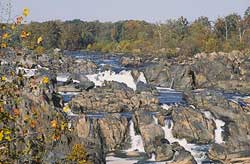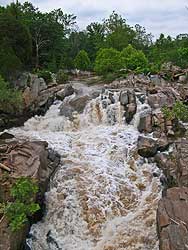The Great Falls of the Potomac

Many people consider the Great Falls of the Potomac to be the most spectacular natural landmark in the Washington D.C. metropolitan area. Here, the Potomac River builds up speed and force as it falls over a series of steep, jagged rocks and flows through the narrow Mather Gorge. This dramatic scene makes Great Falls Park, located just fifteen miles from the Nation's Capital, a popular site with local residents and tourists from around the world who are visiting the Washington area.
 The falls consist of cascading rapids and several 20 foot waterfalls, with a
total 76 foot drop in elevation over a distance of less than a mile. The
Potomac River narrows from nearly 1000 feet, just above the falls, to between 60 and
100 feet wide as it rushes through Mather Gorge, a short distance below the
falls. The Great Falls of the Potomac
display the steepest and most spectacular fall line rapids of any eastern
river.
The falls consist of cascading rapids and several 20 foot waterfalls, with a
total 76 foot drop in elevation over a distance of less than a mile. The
Potomac River narrows from nearly 1000 feet, just above the falls, to between 60 and
100 feet wide as it rushes through Mather Gorge, a short distance below the
falls. The Great Falls of the Potomac
display the steepest and most spectacular fall line rapids of any eastern
river.
 The geologic history of the falls is an interesting one.
After the last ice age, the ocean levels dropped, forcing the Potomac
river to carve deeper in its path to the sea. The overlying rock was
eroded away exposing a much harder, resistant rock formation. This
hard layer is principally made up of metamorphic
and igneous rock, and may be seen throughout the park. For thousands
of years the Potomac river has eroded the bedrock, causing the falls
to recede upstream from a point 9 miles downstream near Chain Bridge
to its current position at Great Falls. Great Falls Park is
located along the boundary between the Piedmont Plateau and the
Atlantic Coastal Plain, in an area known as the fall zone.
The geologic history of the falls is an interesting one.
After the last ice age, the ocean levels dropped, forcing the Potomac
river to carve deeper in its path to the sea. The overlying rock was
eroded away exposing a much harder, resistant rock formation. This
hard layer is principally made up of metamorphic
and igneous rock, and may be seen throughout the park. For thousands
of years the Potomac river has eroded the bedrock, causing the falls
to recede upstream from a point 9 miles downstream near Chain Bridge
to its current position at Great Falls. Great Falls Park is
located along the boundary between the Piedmont Plateau and the
Atlantic Coastal Plain, in an area known as the fall zone.
Joint fault plains, which are natural fissures in the rock substrata where shifting has occurred, exist in many places in the Piedmont Formation between Chain Bridge and the Great Falls. These areas of faulting have loosened the rock, forming areas of weakness. The force of the river has eroded along these areas changing the river's course to its current position. Evidence of the ancient river beds can be seen in well-rounded boulders, smoothed surfaces and grooves, and beautifully formed potholes which were once formed on the ancient riverbed. The metamorphic rocks provide jagged rocky surfaces and high-walled cliffs, stark and pristine against the crashing waters of the Potomac at the falls and along Mather Gorge.
(Much of the information in this section was adapted from resources provided by the National Park Service.)